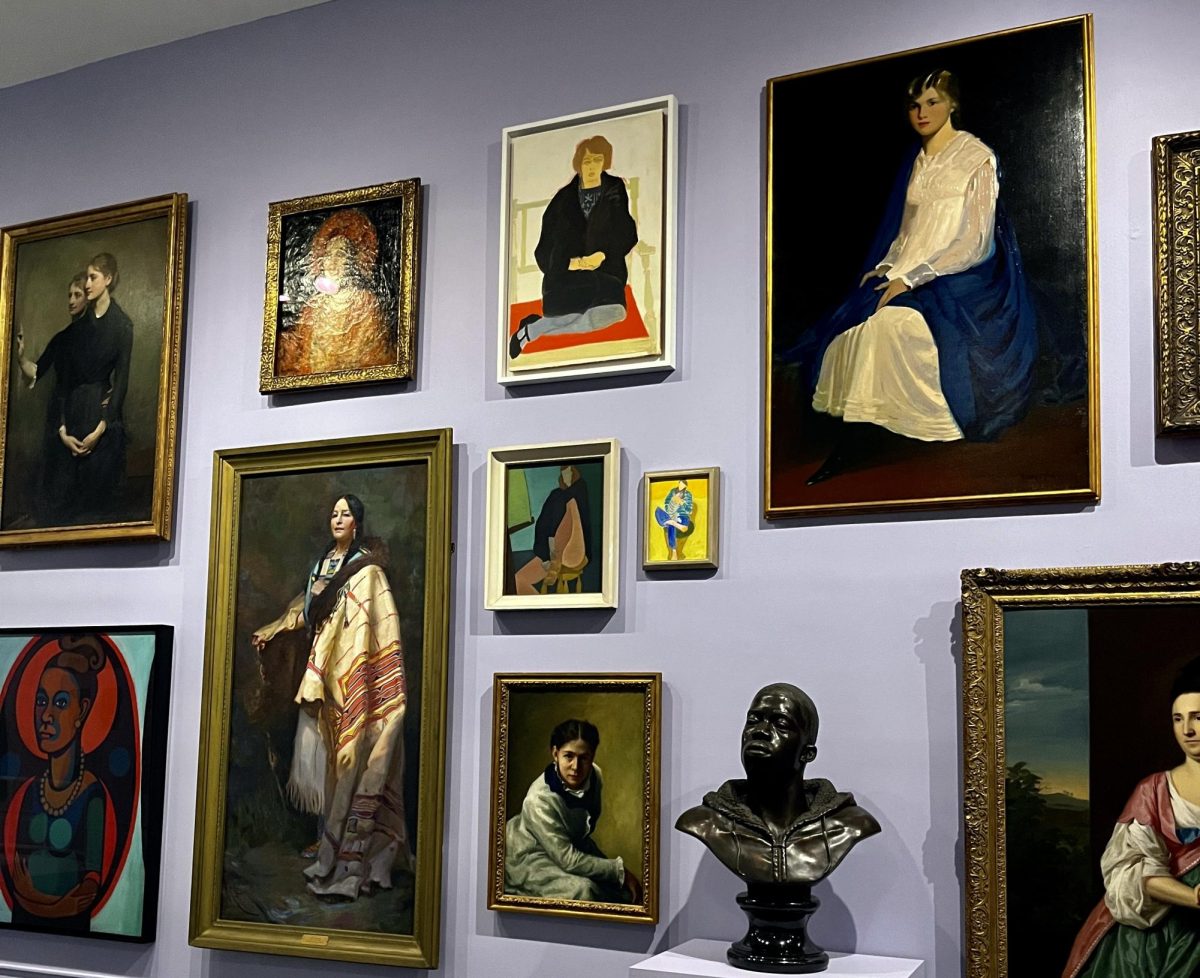In the Brooklyn Museum, a vintage home interior greets visitors as they enter the newly reinstalled American Art galleries. On the deep-green walls hang an array of portraits, transit maps and posters, and on the dark wooden shelves lining the back wall are a variety of objects, including clothing, books and instruments. All of the objects — from the Juneteenth poster to the copy of “Historic Black Brooklyn” — center and celebrate Black material culture found in the home. This room acts as a perfect introduction to “Toward Joy: New Frameworks for American Art,” a renovation grounded in Black feminism and designed to reimagine the ways American art is collected and displayed.
“Toward Joy” opened in October in honor of the Brooklyn Museum’s 200th anniversary. Curated by Stephanie Sparling Williams, the museum’s Andrew W. Mellon Curator of American Art, the galleries display more than 400 works, including both new acquisitions and long-standing pieces from the collection. Split into several sections called “frameworks,” each room has a distinct atmosphere, as the wall colors and organization of the rooms shift as the art-historical frameworks change.
The first section, “Trouble the Water” — which the wall label says is derived from the Black American spiritual “Wade in the Water” — is a useful introduction to these frameworks. Mounted on dark blue walls, this section examines the “powerful links between water and notions of freedom, life, spirituality and transformation.” The placement of works speaks to the different meanings of water across time and cultures. For example, Martin Johnson Heade’s oil painting, “Summer Showers,” next to a Mexica sculpture of the rain god Tlaloc juxtaposes a 19th-century waterscape painting with an Indigenous work in another medium. “Summer Showers” contrasts dark, angry storm clouds in the foreground with the background’s sun-lit hay fields, billowing clouds and blue sky. It is a key example of water as a dramatic, dangerous force in American romantic painting. By contrast, the rain god Tlaloc was worshiped by the Mexica people — also known as Aztecs — for his ability to nurture the earth and agriculture. The carved stone sculpture was likely made as an offering to prevent catastrophic events like droughts and floods, emphasizing the Mexica’s dual recognition of water’s power to both nourish and destroy. Through the objects’ relationship to water, this juxtaposition importantly challenges viewers to consider the impacts of settler colonialism on indigenous ways of life.
Other rooms similarly attempt to dismantle the traditional confinement of American art to 19th and 20th-century paintings by white Americans. “Witness” explores portraiture as a tool for self-representation for the women and people of color who sit for these portraits. I really enjoyed the use of floor-to-ceiling, salon-style hanging, where paintings are hung in a large group that extends above and below eye level. In “Witness,” this arrangement creates the sense that you are surrounded by figures who watch you as you watch them, highlighting the relationship between the viewer and the portraits and encouraging visitors to slow down and simply look.
“A Quiet Place” and “To Give Flowers” similarly focus on specific themes that are depicted across all kinds of American art. “A Quiet Place,” much like “Witness,” encourages viewers to pause and look with care, asking, “Who has access to rest? To peace and quiet?” The works include peaceful landscapes and images of figures resting, and a plush couch and rug create a unique calm and intimate environment that invites viewers to sit, reflect and look with intention.
“To Give Flowers” draws on the saying “to give someone their flowers” from Black funerary and gospel traditions, and explores the use of flowers in the art of different cultures. This section was a personal favorite of mine because of the inclusion of an indigenous Mexica sculpture of the Maize God and colonial-era paintings of the Virgin Mary surrounded by flowers. As a Latina, I so rarely see art from Latin America included in displays of American art. It was both exciting and deeply validating to see pre-colonial Mexican art centered alongside other floral works as a vital point of comparison.
Although most of the galleries were very insightful and presented a wide scope of American art, the section “Several Seats” felt comparatively surface-level. Featuring portraits of wealthy, white individuals from the museum’s collection that are arranged below eye level along the wall, this room allows visitors to critically look down on the subjects of the portraits and their connections to colonialism and slavery. However, the isolation of these portraits from the rest of the gallery — and the labels that seemed more concerned with quippy one-liners than serious critique of collecting practices — meant that “Several Seats” seemed to lack the critical punch of the other rooms, whose arrangement encouraged critique through the conversation between Western and non-Western art. The criticism of these portraits and the Eurocentric collecting practices of the past might have rang truer had it emerged through comparisons between these portraits and portraits of and by historically marginalized people.
As a whole, “Toward Joy” takes a purposeful approach to the display and collection of American art, seeking to directly address the criticisms of historical collecting practices as exclusionary and Eurocentric. Its application of Black feminist frameworks and inclusion of art by marginalized artists across time periods curates a unique display of American art that feels novel, profound and incredibly necessary to the development of museum curatorial practices.
“Toward Joy: New Frameworks for American Art” is now on view on the fifth floor of the Brooklyn Museum as a part of the permanent collection.
Contact Katherine Welander at [email protected].























































































































































